Men's suits in the 1960s reflect a significant evolution in style and culture. You'll notice slim fits, flat fronts, and tapered legs that emphasize a sleek, modern silhouette. Cultural icons like JFK popularized narrow lapels and deeper V shapes, while vibrant colors like avocado green and burnt orange were a bold departure from conservatism. Fabrics like sharkskin added texture and shimmer, showcasing a new aesthetic influenced by youth culture and British mod trends. The shift from structured to more relaxed designs shaped how men dressed for both formal and casual occasions. To explore the full impact of this transformative decade, just go further.
Overview of 1960s Suit Styles

In the vibrant tapestry of men's fashion during the 1960s, suit styles emerged as a striking reflection of the era's cultural shifts and aesthetic preferences. This decade embraced slim-fitting suits, characterized by flat front designs and tapered legs, which created a sleek silhouette that starkly contrasted with the looser styles of previous decades. As you explore these mens suits, you'll notice the defining feature of narrow lapels, which emphasized a streamlined appearance and complemented the minimalist aesthetic that prevailed at the time. Vintage clothing labels were essential in identifying these iconic pieces, providing insights into the craftsmanship and design elements associated with this era.
Sharkskin fabric became a popular choice for suit construction, offering a unique shimmer and texture that enhanced the sophistication of wool suits. Additionally, the inclusion of higher armholes in these designs allowed for improved mobility and comfort, making them practical for everyday wear while still maintaining a tailored look. Cultural icons like JFK influenced the perception of these suits, associating them with sleekness and modernity. Consequently, 1960s suit styles not only represented a shift in fashion but also reflected broader societal changes, making them a significant marker of the era's evolving identity.
Key Features of 1960s Suits
The key features of 1960s suits showcase a remarkable blend of style and functionality, reflecting the era's desire for modernity. You'll notice that these suits typically sport a flat front design, which contributes to a sleek and contemporary appearance. The trim fit, characterized by tapered legs and higher armholes, enhances both mobility and comfort, making them ideal for the active man of the time.
Narrow lapels became a hallmark of 1960s suits, emphasizing a streamlined silhouette that aligns with the minimalist aesthetic dominating fashion. This was often paired with fabrics like sharkskin, known for its unique shimmer and texture, giving the suit an eye-catching quality. If you opt for a double-breasted style, you'll find that it adds a touch of sophistication while maintaining the modern lines of the suit.
Colors like navy and blue were especially popular, offering versatility and a classic appeal. Tailoring techniques during this decade emphasized craftsmanship, with most suits being tailor-made, ensuring a perfect fit that stands in stark contrast to the looser styles found in modern suits. Essentially, 1960s suits represent an era of refined elegance and practicality.
Cultural Influences on Suit Design
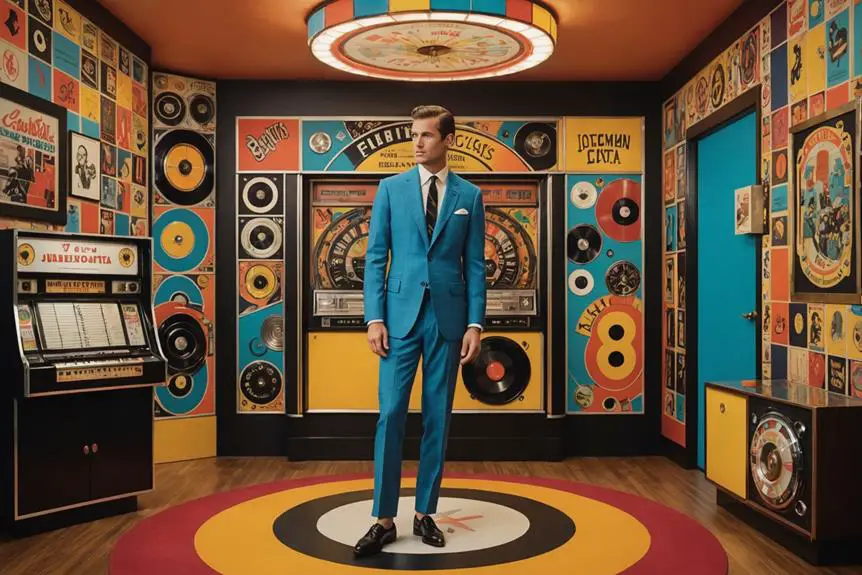
Suit design in the 1960s reflects a rich tapestry of cultural influences that shaped men's fashion during the decade. You can see how icons like JFK popularized modern silhouettes, emphasizing leaner, deeper V shapes that resonated with the youth's desire for sophistication. The British mod culture also played a pivotal role, introducing high collars and collarless jackets, which created a sleek aesthetic that became a staple in American designs.
Musicians such as The Temptations brought vibrant colors into the mix, showcasing bold ensembles that encouraged men to embrace a more daring approach to fashion. This era, often referred to as the "peacocked male" period, thrived on colorful statements and personal expression.
You might notice the emergence of minimalist aesthetics in suits, aligned with the spy genre's influence in media, favoring streamlined looks. Fabric innovations, particularly the advent of blue sharkskin, offered lighter materials that provided breathability and an eye-catching shimmer. Shades like olive green and deep blue became popular, reflecting a shift towards both elegance and individuality. These cultural influences collectively transformed suit design, making it a defining element of 1960s men's fashion.
Popular Fabrics and Patterns
As fashion evolved in the 1960s, the fabrics and patterns used in men's suits mirrored the decade's dynamic spirit and cultural shifts. One standout fabric was sharkskin, celebrated for its unique shimmer created by weaving two different fibers together. This luxurious texture became a hallmark of the era, elevating the traditional wool suit to new heights. In addition to sharkskin, vintage fabrics like wool remained favored for their unmatched quality and drape, reminiscent of classic styles seen in brands like Betty Barclay.
Moving away from the conservative styles of the 1950s, bold patterns like plaids and checks gained popularity, making statements that reflected the youth-driven culture of the time. These eye-catching designs allowed you to express individuality, as the rigid rules of previous decades fell away.
For summer, lightweight tropical wools became the go-to for breathability and comfort, adapting to warmer climates while maintaining a polished appearance. While synthetic blends began to emerge, traditional fabrics like wool remained favored for their unmatched quality and drape.
Vibrant colors also became a defining characteristic of the 1960s, with shades like burnt orange and avocado green capturing the bold aesthetic choices of the time. Embracing these vibrant fabrics and patterns, you could truly embody the spirit of the decade.
Styling Tips for 1960s Suits
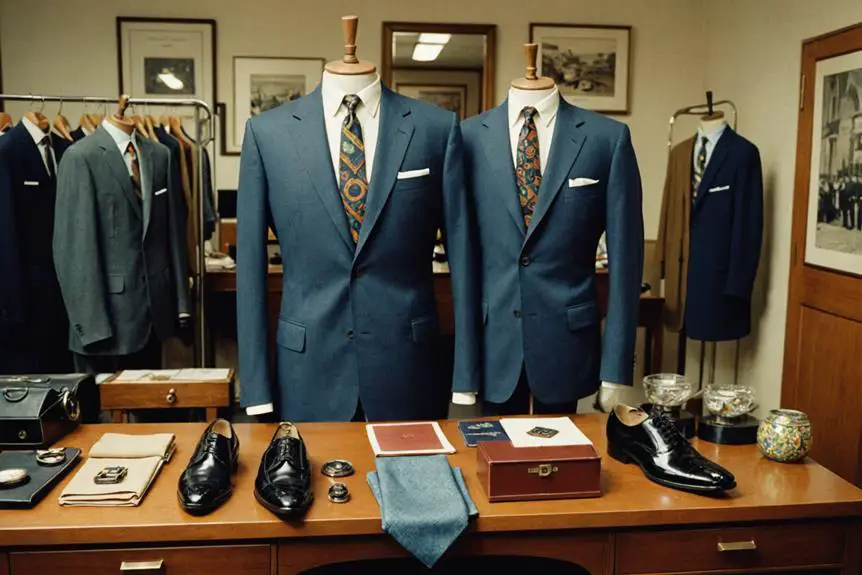
During the vibrant 1960s, mastering the art of styling a suit involved understanding the nuances of the era's aesthetic and the importance of vintage clothing labels. To create a look that embodies this period's charm and sophistication, consider the following tips:
- Choose a button suit jacket with a 3-roll-2 button stance. This design emphasizes a sleek silhouette and reflects the modern appeal of the time.
- Pair your suit with a white oxford cloth button-down (OCBD) shirt and a brown 1930s summer tie. This combination offers a sophisticated yet relaxed vibe, perfect for various occasions, especially when you consider the influence of historical context and types of labels.
- Add a linen pocket square to elevate your ensemble. The pocket square not only introduces elegance but also complements the lightweight fabric of your suit.
- Opt for sockless tassel loafers to maintain a laid-back feel. This choice aligns seamlessly with the 1960s aesthetic of minimalism and comfort, allowing you to exude effortless style.
Evolution of Men's Formal Wear
The evolution of men's formal wear in the 1960s reflects a dynamic interplay of cultural shifts and fashion innovation. You'll notice a marked departure from the conservative, structured styles of the 1950s to more relaxed, unstructured fits that emphasize comfort and ease of movement. This period saw the rise of bold patterns and vibrant colors, moving away from the muted tones that dominated the previous decade. Influenced by icons like JFK, modern silhouettes became the norm, showcasing deeper V shapes.
Ivy sack suits gained traction, characterized by natural shoulders and minimal darts, which resonated with the laid-back aesthetic embraced by youth culture. The introduction of lightweight fabrics, such as tropical wool and wool flannel, made suits more versatile, suitable for both formal and casual occasions. This innovation highlighted the era's evolving fashion landscape.
Additionally, the British mod culture notably impacted American suit designs, leading to the incorporation of high collars and collarless jackets. These tailored fits marked a modern reinterpretation of men's formal wear, where a navy blue suit could be both stylish and comfortable, reflecting the newfound freedom in how you express yourself through fashion.
Notable Designers and Brands

With the evolving landscape of men's formal wear in the 1960s came a wave of notable designers and brands that shaped the era's aesthetic. Designers like Pierre Cardin and Yves Saint Laurent introduced bold patterns and relaxed fits, influencing men's fashion appreciably. Meanwhile, British tailoring houses such as Anderson & Sheppard upheld a reputation for high-quality craftsmanship, emphasizing natural shoulders and slim silhouettes.
Key brands and designers from this transformative era included:
- Brooks Brothers – Renowned for its classic styles, often featuring dark navy and brown wool suits that appealed to the sophisticated gentleman.
- Hart Schaffner Marx – Merging traditional designs with modern elements, they catered to the fashion-conscious man.
- Savile Row Tailors – Offering bespoke suits that exemplified British tailoring excellence.
- Montague Burton – Pioneering ready-to-wear suiting, making stylish options accessible to a broader audience.
Cultural icons like John F. Kennedy further popularized the trend toward slimmer, tailored suits, cementing the sophisticated image of the 1960s gentleman. This era marked a pivotal shift in how men approached formal wear, blending classic elegance with contemporary flair.
Vintage Suit Shopping Guide
Exploring the world of vintage suit shopping can be both exciting and intimidating, especially when searching for the quintessential 1960s style. To start, focus on flat front designs and trim fits that feature higher armholes, as these aspects guarantee comfort and mobility. Look for suits made from sharkskin, which offers a distinctive shimmer and texture that enhances the overall character of your ensemble.
While browsing, pay attention to specific tailoring details. Narrow lapels and minimal breaks in SUIT PANTS reflect the streamlined silhouette typical of the era. You might also come across unique options, like a striking green wool suit or a classic blue pinstripe design, both of which are emblematic of the decade's fashion.
It's crucial to check the sizing, as many vintage suits range from 36R to 46, assuring you can find a good fit for your body type. Don't hesitate to try on different styles to see what suits you best. Vintage shopping can be a treasure hunt, so keep an eye out for those standout pieces that not only capture the essence of the 1960s but also elevate your wardrobe.
Price Ranges for 1960s Suits
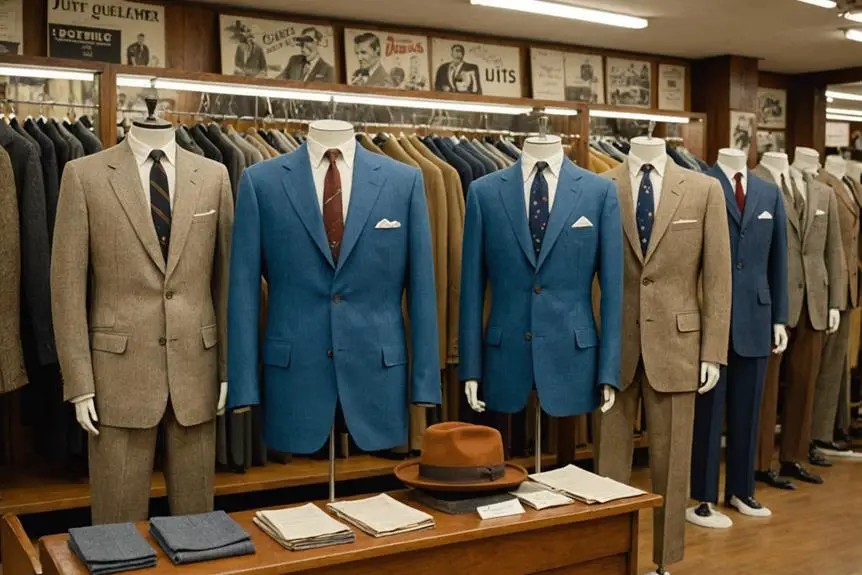
Steering through the price ranges for 1960s suits reveals a diverse landscape influenced by factors like style, condition, and rarity. On average, you can expect to pay around $150 for a vintage 1960s suit, but prices can vary widely. Here are some examples to evaluate:
- Basic Styles: A 1960s Green Gold Wool Suit can be found for as low as $49.99 plus shipping.
- Mid-Range Options: Look for suits like the Artistry by Andover Brown Black Stripe Suit, priced at $185.00 plus shipping.
- Shipping Costs: Don't forget that shipping typically ranges from $5.00 to $26.95, which can add to your total expenditure.
- Negotiable Prices: Many listings come with "or Best Offer," allowing you to negotiate, potentially lowering the final sale price.
The demand for vintage 1960s suits remains high, with many listings attracting significant interest. This dynamic market means you should stay vigilant and be prepared to act quickly if you spot a suit that catches your eye within your desired price range.
Iconic Moments in Suit History
Throughout the 1960s, significant moments in suit history shaped men's fashion, marking a departure from the rigid styles of previous decades. The Ivy sack suit emerged, characterized by natural shoulders and minimal darts, embodying a more relaxed tailoring approach. This shift indicated a growing desire for comfort without sacrificing style.
JFK's presidency also played a significant role, as his affinity for fitted suits with deeper V-shaped lapels set new benchmarks for modern silhouettes. Meanwhile, the Rat Pack, with their signature dark blue weight suits, epitomized sophistication and charisma, influencing countless men's wardrobes.
Additionally, the rise of sharkskin fabric offered a unique shimmer, elevating suits for both formal and casual occasions. Iconic figures like Sean Connery's James Bond showcased sleek, sophisticated designs that became synonymous with the spy genre, reinforcing the era's emphasis on sharp tailoring.
Moreover, the introduction of durable press technology led to wrinkle-resistant shirts, enhancing the practicality of the fitted suits that defined this decade. These moments collectively transformed men's fashion, merging elegance with a newfound sense of ease, and establishing styles that resonate even today.
Frequently Asked Questions
What Kind of Suits Did Men Wear in the 60s?
In the 60s, you'd see men wearing suits with a trim fit, narrow lapels, and flat front trousers. The sleek silhouette often featured sharkskin fabric, blending sophistication with modern style, appealing to the era's cultural icons.
What Did Popular Male 60S Wear?
You'd notice popular male fashion in the 60s embraced bold patterns, vibrant colors, and tailored fits. Accessories like skinny ties and stylish shoes complemented looks, reflecting a confident, modern aesthetic that defined the decade's cultural evolution.
What Did Men Look Like in the 1960s?
In the 1960s, you'd notice men exuding confidence with sleek, tailored outfits, often in lightweight fabrics. Their styles reflected a modern aesthetic, influenced by cultural icons, emphasizing a perfect fit and a minimalist, sophisticated look.
What Did Suits Look Like in the 1950s?
In the 1950s, suits featured structured shoulders, defined waists, and single-breasted designs. You'd see subdued colors like navy and grey, often with classic pinstripes, reflecting a polished, formal aesthetic prevalent during that era.
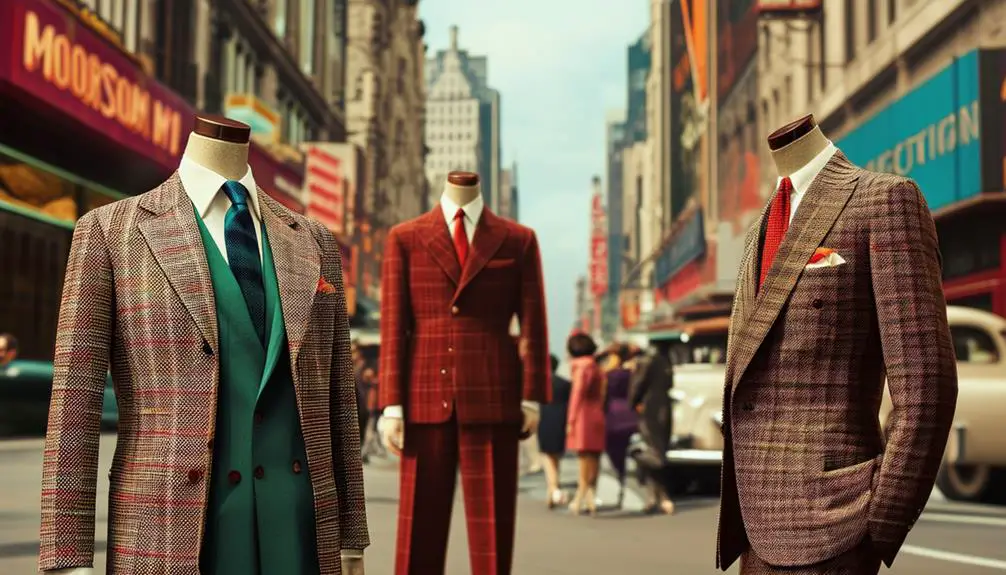



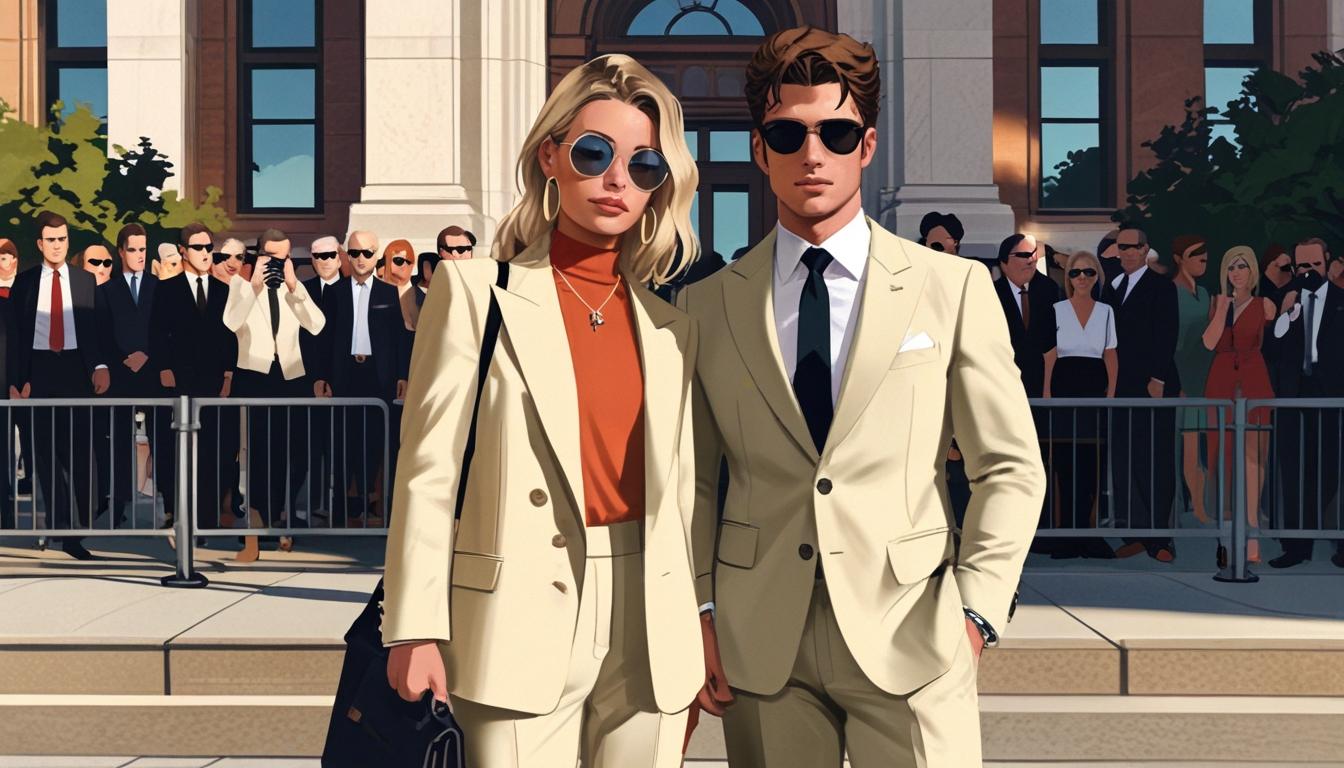
Thank you for your sharing. I am worried that I lack creative ideas. It is your article that makes me full of hope. Thank you. But, I have a question, can you help me? https://www.binance.info/pt-PT/register?ref=DB40ITMB
I don’t think the title of your article matches the content lol. Just kidding, mainly because I had some doubts after reading the article. https://www.binance.com/en-NG/register?ref=JHQQKNKN